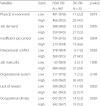1. Yum B, Roh J, Ryu J, Won J, Kim C, Lee J, Kim K. Symptoms of PTSD according to individual and work environment characteristics of Korean railroad drivers with experience of person-under-train accidents. J Psychosom Res. 2006; 61(5):691–697. DOI:
10.1016/j.jpsychores.2006.07.005. PMID:
17084148.
2. Weiss KJ, Farrell JM. PTSD in railroad drivers under the Federal employers’ liability act. J Am Acad Psychiatry Law. 2006; 34(2):191–199. PMID:
16844799.
3. Theorell T, Leymann H, Jodko M, Konarski K, Norbeck HE. ‘Person under train’ incidents from the subway driver’s point of view--a prospective 1-year follow-up study: the design, and medical and psychiatric data. Soc Sci Med. 1994; 38(3):471–475. DOI:
10.1016/0277-9536(94)90449-9. PMID:
8153753.
4. Kim H, Yim H, Jo S, Choi B, Jeong S, Lee K, Park J, Chang S. Major depressive disorder, panic disorder, and post-traumatic stress disorder in Korean subway drivers. Int Arch Occup Environ Health. 2013; 86(4):471–477. DOI:
10.1007/s00420-012-0779-z. PMID:
22592394.
5. Kim S, Kim H, Park J, Lee H, Lee J, Byun J, Yim H. The association between psychiatric disorders and work-related problems among subway drivers in Korea. Ann Occup Environ Med. 2014; 26(1):39. DOI:
10.1186/s40557-014-0039-7. PMID:
25493204.
6. Jo S, Yim H, Kim H, Lee K, Park J, Chang S. Association of subway driver’s depressive symptoms and experience of work-related problems. Epidemiol Health. 2010; 32:e2010010. DOI:
10.4178/epih/e2010010. PMID:
21191463.
7. Woo J, Kang T, Lee J. Increasing risk of mental health problems among subway drivers experiencing accidents on the track. Korean J Occup Environ Med. 2005; 17(1):36–43.
8. Bauer AM, Chan YF, Huang H, Vannoy S, Unutzer J. Characteristics, management, and depression outcomes of primary care patients who endorse thoughts of death or suicide on the PHQ-9. J Gen Intern Med. 2013; 28(3):363–369. DOI:
10.1007/s11606-012-2194-2. PMID:
22936288.
9. Chang S, Koh S, Kang D, Kim S, Kang M, Lee C, Chung J, Cho J, Son M, Chae C, et al. Developing an occupational stress scale for Korean employees. Korean J Occup Environ Med. 2005; 17:297–317.
10. Cho M, Hahm B, Suh D, Hong J, Bae J, Kim J, Lee D, Cho S. Development of a Korean version of the Composite International Diagnostic Interview (K-CIDI). J Korean Neuropsychiatr Assoc. 2002; 41(1):123–137.
11. WHO. The Composite International Diagnostic Interview (CIDI). 1997. Geneva: World Health Organization.
12. APA. Diagnostic and Statistical Manual of Mental Disorders (DSM-IV). 1994. 4. Washington: American Psychiatric Press.
13. WHO. Procedures for the Development of New Language Versions of the WHO Composite International Diagnostic Interview (WHO-CIDI). 1997. Geneva: World Health Organization.
14. American Psychiatric Association: Diagnostic and Statistical Manual of Mental Disorders. 5th edition. Washington (DC): American Psychiatric Press; 2013.
15. Cothereau C, de Beaurepaire C, Payan C, Cambou JP, Rouillon F, Conso F. Professional and medical outcomes for French train drivers after “person under train” accidents: three year follow up study. Occup Environ Med. 2004; 61(6):488–494. DOI:
10.1136/oem.2003.007922. PMID:
15150387.
16. Yoon JH, Chang SJ. 0130 the combined effects of high emotional demands and low job control at work on suicidal ideation in Korean sales and service workers. Occup Environ Med. 2014; 71(Suppl 1):A76–77. DOI:
10.1136/oemed-2014-102362.238.
17. Kim T, Kim K, Ahn Y. Relationship between job stress and depressive symptoms among field firefighters. Korean J Occup Environ Med. 2010; 22:378–387.
18. An SJ, Chung Y, Kim B, Kwak K, Son JS, Koo JW, Ju YS, Kwon YJ. The effect of organisational system on self-rated depression in a panel of male municipal firefighters. Ann Occup Environ Med. 2015; 27(1):1. DOI:
10.1186/s40557-014-0044-x. PMID:
25729584.
19. Lim D-K, Baek K-O, Chung I-S, Lee M-Y. Factors related to sleep disorders among male firefighters. Ann Occup Environ Med. 2014; 26(1):11. DOI:
10.1186/2052-4374-26-11. PMID:
24864191.
20. Yoon S, Choi S, Shin D, Chung I, Ha J. Job stressors in subway workers and firemen. Korean J Occup Environ Med. 2007; 19(3):179–186.
21. Klonsky ED, May AM. The Three-Step Theory (3ST): a new theory of suicide rooted in the “ideation-to-action” framework. Int J Cogn Ther. 2015; 8(2):114–129. DOI:
10.1521/ijct.2015.8.2.114.
22. Van Heeringen K, Hawton K, Williams JMG. Pathways to suicide: an integrative approach. 2000. p. 223–234.
23. Neeleman J, de Graaf R, Vollebergh W. The suicidal process; prospective comparison between early and later stages. J Affect Disord. 2004; 82(1):43–52. DOI:
10.1016/j.jad.2003.09.005. PMID:
15465575.
24. Renberg ES. Self-reported life-weariness, death-wishes, suicidal ideation, suicidal plans and suicide attempts in general population surveys in the north of Sweden 1986 and 1996. Soc Psychiatry Psychiatr Epidemiol. 2001; 36(9):429–436. DOI:
10.1007/s001270170020. PMID:
11766974.
25. Crosby AE, Cheltenham MP, Sacks JJ. Incidence of suicidal ideation and behavior in the United States, 1994. Suicide Life Threat Behav. 1999; 29(2):131–140. PMID:
10407966.
26. Gliatto MF, Rai AK. Evaluation and treatment of patients with suicidal ideation. Am Fam Physician. 1999; 59(6):1500–1506. PMID:
10193592.










